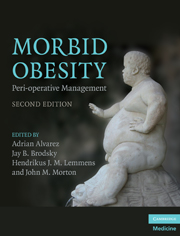Book contents
- Morbid Obesity
- Morbid Obesity
- Copyright page
- Contents
- Contributors
- Preface to the Second Edition
- Preface to the First Edition
- Abbreviations
- Section 1 Pathophysiology
- Section 2 Preparation and pre-operative evaluation/management
- Section 3 Intra-operative management
- Section 4 Post-operative conditions
- 15 Post-operative analgesia
- 16 Post-anesthesia care unit: Management of anesthetic and surgical complications
- 17 Intensive care management of the critically ill obese patient
- 18 Post-operative rhabdomyolysis
- 19 Nursing considerations
- 20 Long-term complications following surgery
- 21 Anesthetic considerations for the post-bariatric surgery patient
- 22 Bariatric outcomes
- Section 5 Special topics
- Index
18 - Post-operative rhabdomyolysis
from Section 4 - Post-operative conditions
Published online by Cambridge University Press: 04 May 2010
- Morbid Obesity
- Morbid Obesity
- Copyright page
- Contents
- Contributors
- Preface to the Second Edition
- Preface to the First Edition
- Abbreviations
- Section 1 Pathophysiology
- Section 2 Preparation and pre-operative evaluation/management
- Section 3 Intra-operative management
- Section 4 Post-operative conditions
- 15 Post-operative analgesia
- 16 Post-anesthesia care unit: Management of anesthetic and surgical complications
- 17 Intensive care management of the critically ill obese patient
- 18 Post-operative rhabdomyolysis
- 19 Nursing considerations
- 20 Long-term complications following surgery
- 21 Anesthetic considerations for the post-bariatric surgery patient
- 22 Bariatric outcomes
- Section 5 Special topics
- Index
Summary
- Type
- Chapter
- Information
- Morbid ObesityPeri-operative ManagementPublisher: Cambridge University PressPrint publication year: 2010
- 3
- Cited by



